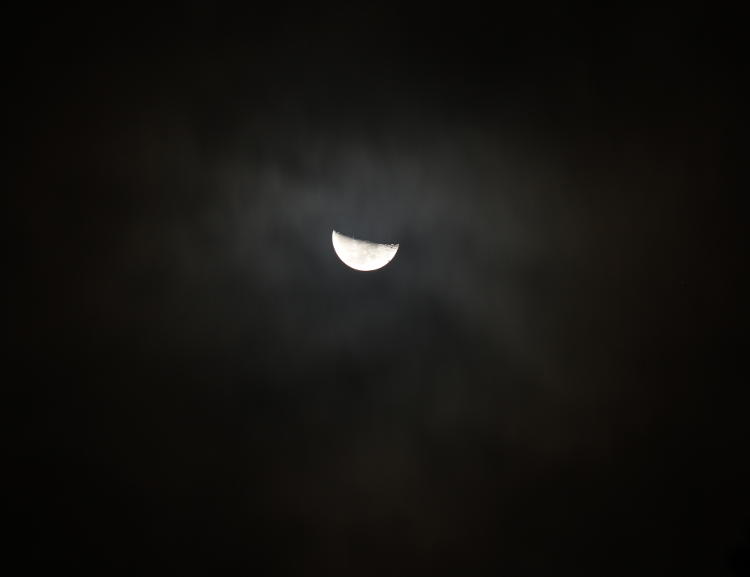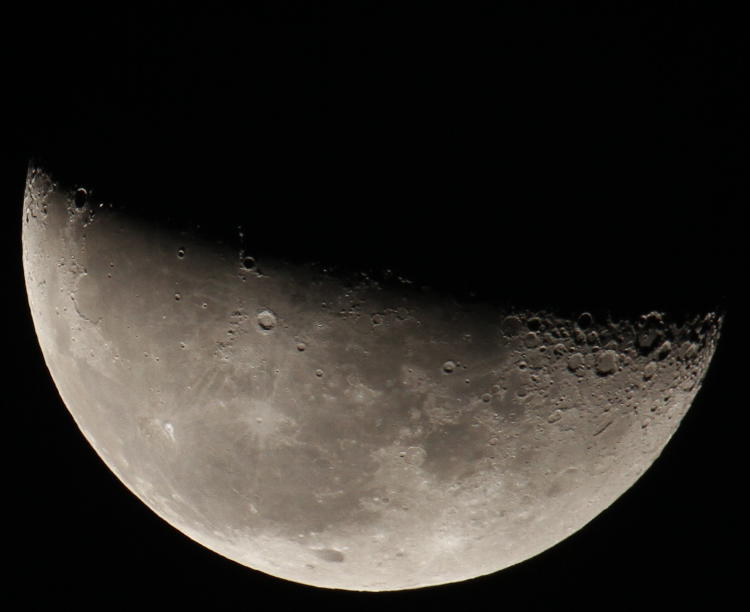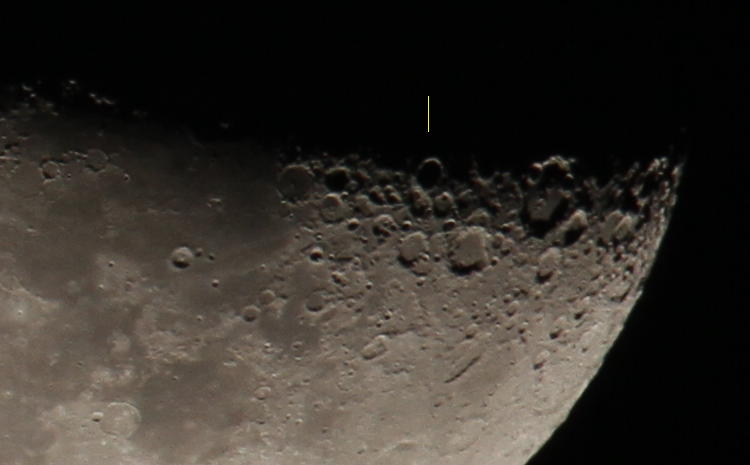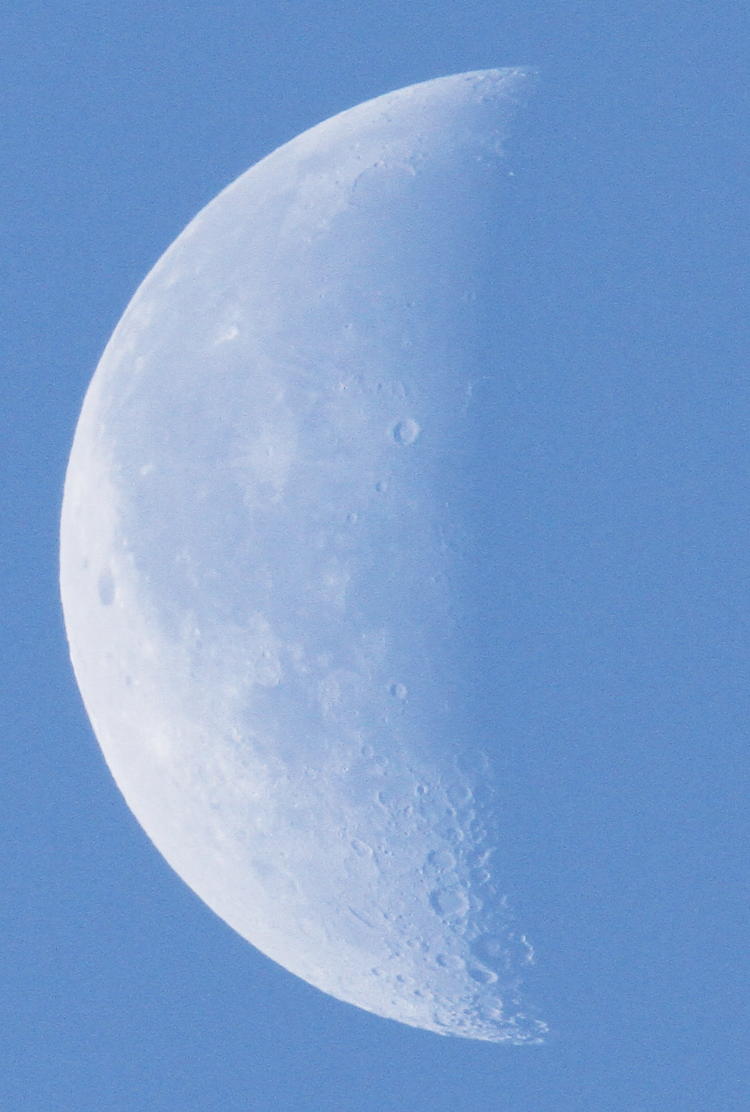The sky did indeed clear enough to do some detailed moon shots, but alas, I was a hair too late.
For those just joining us and not having read enough posts on this blog, get the fuck out no one wants your kind around here I have, for no reason that anyone should examine closely, had the goal of just catching sunrise on the central peak of Tycho, probably the best known crater on the moon. Due to the geological nature of meteor impacts, the crater has a mountain of debris right in the middle, meaning that as the sun rises across the lunar landscape, at some point it touches the tip of this mountain before any portion within, and this is just barely visible from Earth, with enough magnification. If your timing is right.
Sunrise takes place a lot slower on the moon than it does here, because the moon rotates much slower, so the opportunity is much broader than here, but still fairly specific – I honestly don’t know what the exact window is, only that I keep missing it. This morning, I was aiming for sunset instead, because it’s dusk there now. Missed that too. Or I caught it, depending on your view, but to be specific, the sun was no longer illuminating that peak.
First, however, the conditions. In the previous post I said they were shitty but improving, and they improved enough to be of use, but not perfect – there was still a bit of haze in the sky obscuring things a little, and throwing a glow around the moon in a widely variable manner.

I bracketed exposure fairly broadly (never trust the camera meter for such things) to try and bring out the haze while retaining a smidgen of moon detail, and this was probably the best I was gonna get – you can see some scribbling along the terminator there. But we can do better.

This is tightly cropped of course, but about half the camera’s resolution, and my guess a few days ago of when to come back was fairly solid – there’s a chance that, had I been able to see the moon when I first checked (about 1 AM,) I might have just caught it. Taken about 5 AM, this was certainly too late. Let’s check the replay, shall we?

This is a full-resolution crop now. The yellow line is pointing to Tycho, and as you can see, they ain’t no bright spots within the crater. Nertz.
The larger crater over to the right in the image, with a couple of smaller craters superimposed on the rim, is Clavius, while the small crater (with its own peak) sitting largely by itself in Mare Nubium is Bullialdus. There’s a chance I may go out a little later, after the sun is up here, and see if I can snag sunset on the peak in Bullialdus – it’ll be a little harder to make out since the air between us will be lit up by the sun, and scattering light more. Still, these were shot through a lot of humidity, so…
While we’re doing this, let’s see some detail over to the left.

The more distinctive crater almost centered in the image is Copernicus, and this was noticeably the sharpest image that I got in the session, because some faint details of the rubble within Copernicus can be seen. Above it, more shadowed, is Eratosthenes, sitting at the end of the Lunar Apennines, a curving mountain range that shows up fairly well from Earth in the right conditions, even naked eye, and provides just a couple of specks here looming out of the shadows of the terminator. Most of that smooth open space is Mare Imbrium.
[By the way, these details are way the hell too small to make out in the viewfinder, so even with all attempts to render things as sharp as possible, manual or autofocus, really really precise focus is still a matter of chance, so refocus frequently. You can see that the sharpness is fading even around the curve of the moon, though some of this may be due to slightly thicker haze randomly distributed through the frame.]
One more thing to point out in this image. You can see two shallow craters ‘holding hands’ over to the right edge, little more than circles – those are Parry and Guericke. Continue the line that they create, to the left just slightly more than the distance between, and you’re within Frau Mauro, the landing site of Apollo 14 (and the proposed landing site of Apollo 13, before it blew a tire.) And no, no details of any landing sites can be made out from Earth, no matter what the telescope – they can barely be discerned from satellites orbiting the moon itself. BUT, go here, and use the zoom function. The dark spot towards the lower left marks the lander itself, and the squiggly lines are the tracks of the rover. For an idea of scale within my own image, though, the outer rims of Parry and Guericke are somewhere around 90 km (55 mi) apart.
A couple other notes, should you be attempting this yourself:
Turn off image stabilization, or whatever your manufacturer calls it. It was actually responsible for more than a few blurred images when it was activating for no reason, since the camera was on a tripod. Have the tripod as low as you can get it. This reduces vibration. I was aiming pretty high in the sky for this, and would have had to have the center column raised a lot to use the viewfinder comfortably. Instead, I was sitting in the road (the trees in the immediate vicinity were blocking all views from the yard) behind my car. Use a remote release. Don’t touch the camera. You’ll see why in a moment. Mirror lock up is a great idea. This is exactly the kind of thing it’s used for. Bracket exposure and focus widely. You’ll take a lot of shots, but a couple of keepers is all you need. Don’t trust the LCD preview, for focus, exposure, or sharpness confirmation. It’s good for none of these, and in fact, good for almost nothing.
Here’s another look at a different exposure, which may bring out more shadow detail (no, still no sun on Tycho’s peak.)

This is a bit overexposed, especially since the moon material itself pretty much counts as 18% grey, perfect midtones. Notice how the lower edge gets really bright, which is because it’s getting more direct sunlight than the twilight areas front and center.
And as a final aspect, I shot a few moments of video while out there, letting the camera pick its own exposure – it gets a bit darker, but the movement of the clouds/haze becomes much more apparent.
The vibrations, start and end, come from my own hands pushing the Record button on the back of the camera, and this was despite my attempts to be as motionless as possible – why a remote release is highly recommended. But for giggles, just as the video starts, put your finger on the screen right at the bottom edge of the moon, and watch it move away from your finger – this is the actual movement of the moon in that time (or the rotation of the Earth, pick the frame of reference that suits your worldview.)
Okay, so. While typing this out, The Girlfriend wanted to get some materials for a home project, so I had a mid-length interruption in there, and decided when we got back to shoot the moon again. Result: that shadow isolating the base of the peak in Bullialdus hasn’t noticeably advanced, even though Eratosthenes has about vanished. But check it for yourself:

Again, Bullialdus is that smaller distinct crater, about two-thirds of the way down, all by itself.
Now, don’t ask me about that grain, because I’m curious about it myself, and don’t think it should be there, but that’s a topic for another post perhaps. As for the orientation, well, that’s the way I shot it, but I was turned almost ninety degrees from the direction I was facing for the earlier shots. and the moon had tracked quite a bit more (for one, I no longer had to sit in the road.) So these are ‘as viewed,’ but at different points during the moon’s arc, so the moon is facing differently, yet still the same. Very zen. I think.




















































